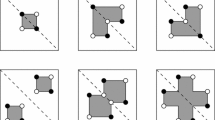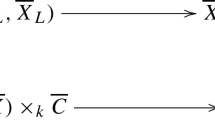Abstract
We develop the affine sieve in the context of orbits of congruence subgroups of semisimple groups acting linearly on affine space. In particular, we give effective bounds for the saturation numbers for points on such orbits at which the value of a given polynomial has few prime factors. In many cases these bounds are of the same quality as what is known in the classical case of a polynomial in one variable where the orbit consists of the integers. When the orbit is the set of integral matrices of a fixed determinant, we obtain a sharp result for the saturation number, and thus establish the Zariski density of matrices all of whose entries are prime numbers. Among the key tools used are explicit approximations to the generalized Ramanujan conjectures for such groups, and sharp and uniform counting of points on such orbits when ordered by various norms.
Similar content being viewed by others
References
Arthur, J. & Clozel, L., Simple Algebras, Base Change, and the Advanced Theory of the Trace Formula. Annals of Mathematics Studies, 120. Princeton University Press, Princeton, NJ, 1989.
Bass, H., Milnor, J. & Serre, J.P., Solution of the congruence subgroup problem for SL n (n ≥ 3) and Sp2n (n ≥ 2). Inst. Hautes Études Sci. Publ. Math., 33 (1967), 59–137.
Borel, A., Density properties for certain subgroups of semi-simple groups without compact components. Ann. of Math., 72 (1960), 179–188.
Borel, A. & Harish-Chandra, Arithmetic subgroups of algebraic groups. Ann. of Math., 75 (1962), 485–535.
Bourgain, J., Gamburd, A. & Sarnak, P., Affine linear sieve, expanders, and sum-product. Invent. Math., 179 (2010), 559–644.
Burger, M. & Sarnak, P., Ramanujan duals. II. Invent. Math., 106 (1991), 1–11.
Chebotarev, N.G., Determination of the density of the set of prime numbers, belonging to a given substitution class. Izv. Ross Akad. Nauk, 17 (1923), 205–250 (Russian).
Clozel, L., Démonstration de la conjecture τ. Invent. Math., 151 (2003), 297–328.
— Spectral theory of automorphic forms, in Automorphic Forms and Applications, IAS/Park City Math. Ser., 12, pp. 43–93. Amer. Math. Soc., Providence, RI, 2007.
Colin de Verdière, Y., Ergodicité et fonctions propres du laplacien. Comm. Math. Phys., 102 (1985), 497–502.
Diamond, H. G. & Halberstam, H., A Higher-Dimensional Sieve Method. Cambridge Tracts in Mathematics, 177. Cambridge University Press, Cambridge, 2008.
Duke, W., Rudnick, Z. & Sarnak, P., Density of integer points on affine homogeneous varieties. Duke Math. J., 71 (1993), 143–179.
Gangolli, R. & Varadarajan, V. S., Harmonic Analysis of Spherical Functions on Real Reductive Groups. Ergebnisse der Mathematik und ihrer Grenzgebiete, 101. Springer, Berlin–Heidelberg, 1988.
Goldston, D. A., Graham, S.W., Pintz, J. & Yıldırım, C.Y., Small gaps between products of two primes. Proc. Lond. Math. Soc., 98 (2009), 741–774.
Gorodnik, A. & Nevo, A., The Ergodic Theory of Lattice Subgroups. Annals of Mathematics Studies, 172. Princeton University Press, Princeton, NJ, 2010.
— Counting lattice points. To appear in J. Reine Angew. Math.
Gorodnik, A. & Weiss, B., Distribution of lattice orbits on homogeneous varieties. Geom. Funct. Anal., 17 (2007), 58–115.
Halberstam, H. & Richert, H.E., Sieve Methods. London Mathematical Society Monographs, 4. Academic Press, London–New York, 1974.
Iwaniec, H. & Kowalski, E., Analytic Number Theory. American Mathematical Society Colloquium Publications, 53. Amer. Math. Soc., Providence, RI, 2004.
Jacquet, H. & Langlands, R. P., Automorphic Forms on GL(2). Lecture Notes in Mathematics, 114. Springer, Berlin–Heidelberg, 1970.
Kelmer, D. & Sarnak, P., Strong spectral gaps for compact quotients of products \( \mathbb{R} \) of PSL(2,). J. Eur. Math. Soc. (JEMS), 11 (2009), 283–313.
Kim, H. H. & Sarnak, P., Appendix 2 in Kim, H. H., Functoriality for the exterior square of GL4 and the symmetric fourth of GL2. J. Amer. Math. Soc., 16 (2003), 139–183.
Knapp, A.W., Representation Theory of Semisimple Groups. Princeton Mathematical Series, 36. Princeton University Press, Princeton, NJ, 1986.
Lang, S., Algebraic groups over finite fields. Amer. J. Math., 78 (1956), 555–563.
Lang, S. & Weil, A., Number of points of varieties in finite fields. Amer. J. Math., 76 (1954), 819–827.
Li, J.-S., The minimal decay of matrix coefficients for classical groups, in Harmonic Analysis in China, Math. Appl., 327, pp. 146–169. Kluwer, Dordrecht, 1995.
Li, J.-S. & Zhu, C.-B., On the decay of matrix coefficients for exceptional groups. Math. Ann., 305 (1996), 249–270.
Liu, J. & Sarnak, P., Integral points on quadrics in three variables whose coordinates have few prime factors. Israel J. Math., 178 (2010), 393–426.
Loke, H. Y. & Savin, G., Rank and matrix coefficients for simply laced groups. J. Reine Angew. Math., 599 (2006), 201–216.
Matthews, C. R., Vaserstein, L. N. & Weisfeiler, B., Congruence properties of Zariski-dense subgroups. I. Proc. London Math. Soc., 48 (1984), 514–532.
Maucourant, F., Homogeneous asymptotic limits of Haar measures of semisimple linear groups and their lattices. Duke Math. J., 136 (2007), 357–399.
Mennicke, J. L., Finite factor groups of the unimodular group. Ann. of Math., 81 (1965), 31–37.
Moeglin, C. & Waldspurger, J. L., Le spectre résiduel de GL(n). Ann. Sci. École Norm. Sup., 22 (1989), 605–674.
Nevo, A., Spectral transfer and pointwise ergodic theorems for semi-simple Kazhdan groups. Math. Res. Lett., 5 (1998), 305–325.
Noether, E., Ein algebraisches Kriterium für absolute Irreduzibilität. Math. Ann., 85 (1922), 26–40.
Oh, H., Uniform pointwise bounds for matrix coefficients of unitary representations and applications to Kazhdan constants. Duke Math. J., 113 (2002), 133–192.
Platonov, V. P. & Rapinchuk, A. S., Algebraic Groups and Number Theory. Nauka, Moscow, 1991 (Russian).
Sansuc, J. J., Groupe de Brauer et arithmétique des groupes algébriques linéaires sur un corps de nombres. J. Reine Angew. Math., 327 (1981), 12–80.
Sarnak, P., Notes on the generalized Ramanujan conjectures, in Harmonic Analysis, the Trace Formula, and Shimura Varieties, Clay Math. Proc., 4, pp. 659–685. Amer. Math. Soc., Providence, RI, 2005.
— Equidistribution and primes. Astérisque, 322 (2008), 225–240.
Schmidt, W. M., Equations over Finite Fields. An Elementary Approach. Lecture Notes in Mathematics, 536. Springer, Berlin–Heidelberg, 1976.
Terras, A., Harmonic Analysis and Symmetric Spaces and Applications. II. Springer, Berlin–Heidelberg, 1988.
Vaughan, R.C., The Hardy–Littlewood Method. Cambridge Tracts in Mathematics, 80. Cambridge University Press, Cambridge, 1981.
Vinogradov, I. M., Representations of an odd number as a sum of three primes. Dokl. Akad. Nauk SSSR, 15 (1937), 291–294 (Russian).
Author information
Authors and Affiliations
Corresponding author
Additional information
A. N. was supported by the Institute for Advanced Study, Princeton, and ISF grant 975/05. P. S. was supported by an NSF grant and BSF grant 2006254.
Rights and permissions
About this article
Cite this article
Nevo, A., Sarnak, P. Prime and almost prime integral points on principal homogeneous spaces. Acta Math 205, 361–402 (2010). https://doi.org/10.1007/s11511-010-0057-4
Received:
Revised:
Published:
Issue Date:
DOI: https://doi.org/10.1007/s11511-010-0057-4




